第一章 翻译概述
翻译过程
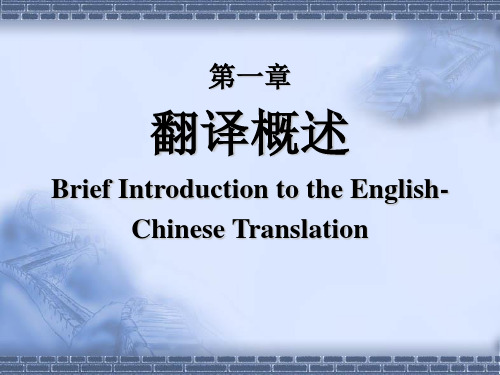
【译文】“他们读书,我付学费; 他们享受,我却劳累。”
18
返回章重点
再如:
Talent Professor Smith has. Money Professor Smith has not.
【译文】才能,史密斯教授有。钱,史密斯教授没有。
综合练习1 综合练习2
课堂互动1 课堂互动2
----end
2
第一章
翻译概述
Brief Introduction to the English-Chinese Translation
3
返回章重点
1. 1 翻译的定义 (Definition of Translation)
● 用一种等值的语言的文本材料去替换另一种语
小点结束
1.7. 2 翻译课的教学任务
翻译课的教学任务就是向学生传授翻 译基础理论、常用的翻译方法、技巧;并 通过大量翻译练习实践扎实语言基础,其 目的是提高学生运用语言的能力,培养他 们的实际翻译技能,使其能在一定的时间 内译出所规定的文字语码,达到相应的翻 译水平。
小点结束
34
返回章重点
1.8 翻译课的重要性
30
返回章重点
形象点说,译者就是一个为读者 传达作者思想的“传话人”,两种语 言文化间的“使者”,出入于两种文 化之间的“双文化人”、“双语人”、 “必须是一个真正意义上的文化人” 。
小点结束
31
返回章重点
1. 6. 2 对译者的要求
称职的译者必须具备以下素质:
● 扎实的语言基础
● 丰富的语言知识
【译文】她们有的长着漂亮的眼睛,有的生着俏丽 的鼻子,有的有着妩媚的嘴巴、婀娜的身段; 但是,这样样都美的,虽然不能说是人间少 有,却也是画里难寻。
翻译第一、二章ppt(1)
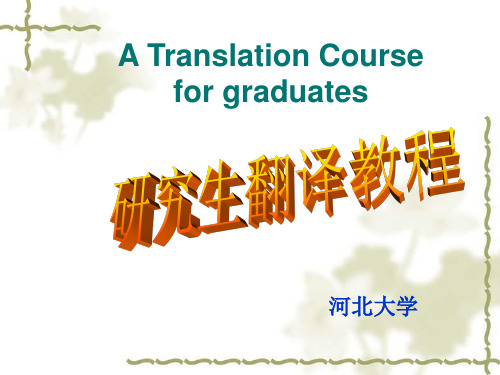
2. …when he was young fellow in the sixties. 当他还是个60多岁的年轻小伙子时。 在60年代,他还年轻时。
3. The object did not move because I pushed it. 因为我推了它,该物体才没有移动。 不是因为我推了它,该物体才移动。
1.4 翻译的“三要”与“三 不要”
“译”精于勤(Practice makes perfect)
☆ 对原文的理解做到“三要” 1) 要正确理解原文词义 例1:He could hardly restrain himself from
shouting aloud.
译文1: 他控制不住自己,大叫了一声。 译文2:他几乎控制不住自己,要喊出声来。/他拼命控制自 己,才没有喊出声来。
二. 弄清原文的逻辑关系 由于不善于逻辑思考,对原文理解歧义,闹出 笑话,历来是翻译的一大忌讳。 1.The old man informed us that his wife had had thirteen children, one in every month of the year and one over besides. 老人风趣地告诉我们,他的妻子生了13个孩子, 每月生一个还多了一个。 老人风趣地告诉我们,他的妻子生了13个孩子, 如果用一年十二个月的名字给他们取名的话, 还多出来一个。
A Translation Course for graduates
河北大学
第一章 翻译概论
1.1 翻译的标准 严复:“信”、“达”、“雅” Faithfulness, Expressiveness, Elegance 王佐良教授的解释为: “信”:指准确传达原作的内容 “达”:指尽量运用读者所习惯的表达方式 “雅”:指通过艺术地再现和加强原作的风格特 色
翻译理论与实践教案

翻译理论与实践教案第一章:翻译概述1.1 翻译的定义与历史1.2 翻译的类型与标准1.3 翻译的基本原则与策略1.4 翻译研究与评价第二章:翻译理论基础2.1 语言与翻译2.2 翻译单位的确定2.3 翻译等值与差异2.4 翻译过程中的文化因素第三章:直译与意译3.1 直译与意译的定义与区别3.2 直译与意译的应用场景3.3 直译与意译的利弊分析3.4 直译与意译的实践案例第四章:翻译技巧与策略4.1 词汇翻译技巧4.2 句子翻译技巧4.3 段落翻译技巧4.4 篇章翻译技巧第五章:计算机辅助翻译5.1 计算机辅助翻译的定义与原理5.2 计算机辅助翻译软件介绍5.3 计算机辅助翻译的优缺点5.4 计算机辅助翻译的实际应用案例第六章:翻译理论与实践案例分析6.1 案例分析的重要性6.2 案例分析的方法与步骤6.3 翻译案例分析实例一6.4 翻译案例分析实例二第七章:文学翻译7.1 文学翻译的特点与要求7.2 文学翻译的基本策略7.3 诗歌、小说、戏剧等不同体裁的翻译7.4 文学翻译实践案例分析第八章:实用文本翻译8.1 实用文本翻译的特点与要求8.2 官方文件、合同、广告等不同类型文本的翻译8.3 实用文本翻译实践案例分析8.4 实用文本翻译的注意事项第九章:口译理论与实践9.1 口译的定义与类型9.2 口译的基本技巧与策略9.3 会议口译、同声传译等不同形式口译的实践案例9.4 口译训练与提高方法第十章:翻译伦理与职业素养10.1 翻译伦理的重要性10.2 翻译伦理的基本原则与规范10.3 翻译过程中的职业素养10.4 翻译行业现状与发展趋势第十一章:本地化与翻译11.1 本地化的概念与过程11.2 翻译在本地化项目中的作用11.3 本地化翻译的策略与技巧11.4 本地化翻译案例分析第十二章:机器翻译与12.1 机器翻译的发展历程与现状12.2 机器翻译的主要技术及其优缺点12.3 在翻译领域的应用12.4 机器翻译与人类翻译的比较与融合第十三章:翻译教学与评估13.1 翻译教学的目标与方法13.2 翻译教学的实践与反思13.3 翻译评估的标准与手段13.4 翻译教学评估案例分析第十四章:翻译行业现状与发展趋势14.1 翻译行业的市场需求与挑战14.2 翻译行业的专业组织与认证14.3 翻译行业的新兴领域与发展方向14.4 翻译从业者的职业规划与终身学习第十五章:翻译案例鉴赏与讨论15.1 翻译案例的选取与分析方法15.2 经典翻译案例鉴赏15.3 引起争议的翻译案例讨论15.4 学生翻译作品的评价与反馈重点和难点解析本文档提供了关于翻译理论与实践的教案内容,涵盖了从翻译概述到翻译案例鉴赏的十五个章节。
新编英汉翻译教程第一章翻译概论ppt课件
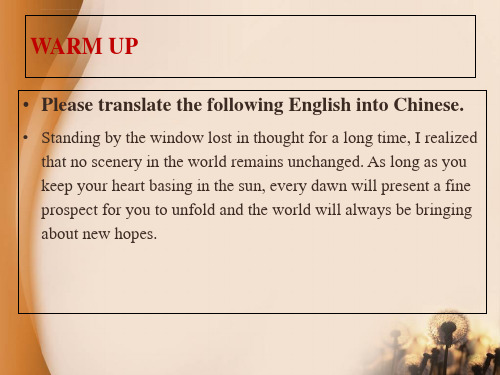
• 一个中学老师把KFC肯德基店里的广告标语“We do chicken right!”发给学生练习翻译,结果有如下答案:
•
01. 我们做鸡是对的!
•
02. 我们就是做鸡的!
•
03. 我们有做鸡的权利!
•
04. 我们只做鸡的右半边!
•
05. 我们只做右边的鸡!
“雪亮工程"是以区(县)、乡(镇) 、村( 社区) 三级综 治中心 为指挥 平台、 以综治 信息化 为支撑 、以网 格化管 理为基 础、以 公共安 全视频 监控联 网应用 为重点 的“群 众性治 安防控 工程” 。
“雪亮工程"是以区(县)、乡(镇) 、村( 社区) 三级综 治中心 为指挥 平台、 以综治 信息化 为支撑 、以网 格化管 理为基 础、以 公共安 全视频 监控联 网应用 为重点 的“群 众性治 安防控 工程” 。
Types of translation
• 3. According to styles (page 5) • 1) practical writings (应用文体)
English Dictionary • translation: the process of changing something that is written
or spoken into anther language. ----Oxford English Dictionary • Translating consists in reproducing in the receptor language
“雪亮工程"是以区(县)、乡(镇) 、村( 社区) 三级综 治中心 为指挥 平台、 以综治 信息化 为支撑 、以网 格化管 理为基 础、以 公共安 全视频 监控联 网应用 为重点 的“群 众性治 安防控 工程” 。
英汉笔译基础教程 第1章 翻译概述

▪ 语内翻译(intralingual translation) ▪ 语际翻译(interlingual translation) ▪ 符际翻译(intersemiotic translation)
❖ 诺德从译文功能来分:
▪ 工具型翻译(instrumental translation) ▪ 文献型翻译(documentary translation)
英汉笔译基础教程
Basics of English to Chinese Translation
第一章 翻译概述
❖ 1.1 翻译的定义与分类 ❖ 1.2 翻译的标准 ❖ 1.3 翻译过程 ❖ 1.4 译者技能
1.1翻译的定义与分类
❖1.1.1 翻译的定义 ❖工具书中的定义
▪ 《说文解字》:“翻”解释为“飞也”,本义是“鸟飞 ”,“译”解释为“传译四夷之言者”。
❖ 把翻译看作一个产业,可分为:
▪ 三个层次:核心层、边缘层及相关层
1.2 翻译的标准
❖ 1.2.1翻译标准的演变 ❖支谦:
▪ “因循本旨,不加文饰”、“案本而传”、“实宜径达 ”
❖玄奘:
▪ “求真”和“喻俗”的翻译标准
❖严复:
பைடு நூலகம்▪ “信、达、雅”
❖鲁迅:
▪ “凡是翻译,必须兼顾两面,一面力求其易解,二则是 保存着原作的丰姿”
1.2.2不同视角下的翻译标准
❖以原文为中心
▪ 对等、忠实的翻译标准。
❖以读者为中心
▪ 流畅与透明
❖以译文功能为中心
▪ 译文在多大程度上满足了翻译的目的
❖以客户为中心的翻译服务标准
▪ 客户的利益在多大程度上得到实现 ▪ 客户的满意度成为判断翻译服务好坏的标准
Unit 1 翻译概述

张宇 蔺玉荣
Unit 1 翻译概述
I. 翻译的定义 II. 翻译的标准 III. 译史简介
I. 翻译的定义
唐代贾公彦在《义疏》一书中写道: 唐代贾公彦在《义疏》一书中写道: 译即易,谓换易言语使相解也。 “译即易,谓换易言语使相解也。” 翻译是把一种语言文字的意义用另 一种语言文字表达出来。 一种语言文字表达出来。 -《现代汉语词典》 -《现代汉语词典》 现代汉语词典
* 《群学肄言》 群学肄言》 (Study of Sociology H. Spencer 斯宾塞 斯宾塞) * 《群己权界论》 群己权界论》 (On Liberty 穆勒 J.S. Miller)
“五四” 时期 翻译史的第三个高峰 五四” 时期---翻译史的第三个高峰 期
* 开始介绍马列主义经典著作和无产阶级 文学作品。陈望道《共产党宣言》、 文学作品。陈望道《共产党宣言》、 李达《政治经济学批判》 李达《政治经济学批判》 * 白话文代替了文言文。 白话文代替了文言文。 * 鲁迅 《毁灭》、《死魂灵》 毁灭》、《死魂灵》 》、《死魂灵
* 玄奘:唐太宗贞观二年(628年)出发 玄奘:唐太宗贞观二年( 年 去印度求经, 年后回国 年后回国。 去印度求经,17年后回国。带回佛经 657部,19年间译出 部佛经,共1335 年间译出75部佛经 部 年间译出 部佛经, 提出“既须求真,又须喻俗” 卷。提出“既须求真,又须喻俗”,即 “忠实、通顺”的翻译标准。 忠实、通顺”的翻译标准。
* * *
* 忠实标准 译者对原著者的责任 忠实标准: * 通顺标准:译者对中国读者的责任 通顺标准: * 美的标准: 译者对艺术的责任 美的标准:
钱钟书: 钱钟书:化境
文学翻译的最高理想可以 说是“ 说是“化”。把作品从一国文 字转变成另一国文字, 字转变成另一国文字,既能不 因语文习惯的差异而露出生硬 牵强的痕迹, 牵强的痕迹,又能完全保存原 作的风味,那就算得入于“ 作的风味,那就算得入于“化 境”。
英汉比较与翻译第一章 英汉翻译概述
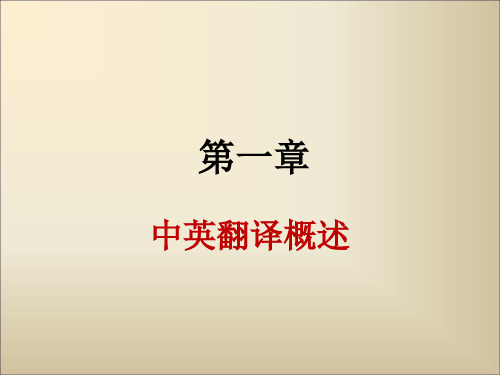
• 4.3 熟练的翻译技巧与策略
翻译技巧是译者在翻译实践中不断总结归纳出来 的,并不是所有的译者都熟练掌握所有的翻译理 论知识,但是几乎所有优秀的译者都会下意识地 或有意识地综合运用各种翻译技巧,如:增词法、 省略法、词类转译法、重复法、词序转换法、合 并法、拆分法等等:
E.g. 1 没有调查就没有发言权。 He who makes no investigation and study has no right to speak. (增加代词) E.g. 2 我不放弃原来的梦想,现在不放弃,将来不放 弃。 I don't abandon my original dream, I never now and never will. (省略重复出现的部分)
笔译(translation/written translation)
机器翻译(machine translation) 人机协作翻译(machine-aided translation)
• 3.3 全译、摘译和编译
全译(full-text translation)
摘译(abridged translation)
a sort of man Friday to the director of the company. (何江波, 2010:20)
译文:他们给了我销售经理的头衔,但我却实在 是给公司领导当忠实助手的材料。 分析:如果没有相关的商务知识,可能会把 “ Sales Manager”译成“销售管理者”,如果对 英国作家笛福的小说《鲁宾逊漂流记》中的 “Friday”一无所知,可能会把“man Friday”译 成“星期五男人”。
第三节 翻译的分类
• 3.1 语内、语际和符翻译
语内翻译(intralingual translation)
翻译概述

翻译理论与实践Translation: Theory & Practice文化与翻译教研室2008年1月•第一章翻译概述•第二章确定词义,表达得体•第三章翻译常用的八种技巧•第四章专有名词和其它一些名词的翻译•第五章英汉声色词互译•第六章书名和标题的翻译•第七章Idioms与熟语的翻译第一章翻译概述•什么是翻译?(Definition)•翻译的起源?(Origins)•翻译的标准?(Principles of Translation)•中西翻译史?(History)•翻译的一般性问题(Some Views on Translation)什么是翻译?(Definition)张培基Eugene A. Nida钟述孔Zhong ShukongCatford J. C.张培基翻译的定义:翻译是运用一种语言把另一种语言所表达的思维内容准确而完整地重新表达出来的语言活动。
Translation is a linguistic practice of employing one language to realize the thoughts expressed in another language exactly and completely.Eugene A. NidaTranslation consists in reproducing in the receptor language the closest natural equivalent of the source language, first in terms of meaning and secondly in terms of style. –By Eugene A. Nida(所谓翻译,是在译语中用切近而又最自然的对等语再现原语的信息,首先是意义,其次是文体。
)Zhong Shukong 钟述孔Translation, essentially, is the faithful representation, in one language, of what is written or said in another language.曾做过周恩来翻译J. C. Catford Translation is the “the replacement of textual material in one language (SL) by equivalent textual material in anotherlanguage (TL)” (J. C. Catford, 1965:20).(翻译是用一种语言(目的语)的文本材料对等地再现另一种语言(源出语)的文本材料。
翻译理论与实践(全套)精品PPT课件
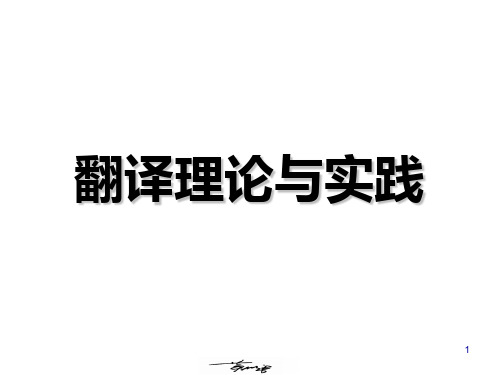
导学——课程要求
Tests: 60% There will be only one test: a final. But there may also be
Main Language points: 1. Comparative studies of language family 2. Comparative studies of word building in English and
Chinese 3. Comparative studies of syllable
Exercise
5
第三章:词语的翻译
教学目的:旨在帮助学生了解词义的多样性 (引申、褒贬);并掌握词语翻译的选词技巧。
教学内容: 1. 词义的选择 2. 词义的引申 3. 词义的褒贬 4. 翻译练习
6
第四章:句子翻译技巧(上)
一、教学目的:要求熟练理解句子的翻译技 巧,从而在英汉翻译时做到通顺、准确。
教学内容: 1. 翻译的定义、分类 2. 翻译的标准 3. 翻译的过程:理解——表达——校对 4. 中、西译史
练习
4
第二章:英汉语言现象对比
Teaching aims: to learn about the similarities and differences of Chinese and English in word forming and vocabulary so as to translate them accurately.
二、教学过程:
1. 增译法 2. 省译法 3. 词类转换 4. 正说反译、反说正译法 5. 翻译练习1、2、3、4
7
第五章:句子翻译技巧(下)
一、教学目的:要求熟练理解句子的翻译技 巧,从而在汉英翻译时做到通顺、准确。
笔译

6
返回章重点 退出
1. 2 翻译史简介
(Brief Account of the History of Translation) 在人类历史上,不同文化之间很早以前就开 在人类历史上, 始了相互交流。 始了相互交流。我们的祖先与世界其他民族文化 的交往也同样源远流长,翻译历史相当悠久。 的交往也同样源远流长,翻译历史相当悠久。张 骞出使西域,丝绸之路开通,玄奘西赴印度, 骞出使西域,丝绸之路开通,玄奘西赴印度,鉴 真和尚东渡日本,以及后来的郑和下西洋, 真和尚东渡日本,以及后来的郑和下西洋,这些 都是我们所熟悉的文化交流活动历史。 都是我们所熟悉的文化交流活动历史。马祖毅认 中国翻译在五四运动之前有三次高潮: 为,中国翻译在五四运动之前有三次高潮:从东 汉至唐宋的佛经翻译,明末清初的科技翻译, 汉至唐宋的佛经翻译,明末清初的科技翻译,鸦 片战争至五四前后的西学翻译。 片战争至五四前后的西学翻译。
8
返回章重点 退出
明末清初的科技翻译是继佛经翻译后翻译活 动的一大转折。明朝后期, 动的一大转折。明朝后期,意大利耶稣会教士利 玛窦(Matteo Ricci,1552-1601) 等数十名西方传教士先 , ) 后进入中国,在中国建立教堂布道, 后进入中国,在中国建立教堂布道,同时把西方 的科学传入中国。 的科学传入中国。这期间翻译了许多西方科学著 比如天文学、算学、物理学、地理学、 作,比如天文学、算学、物理学、地理学、生物 采矿和冶金技术等, 学、采矿和冶金技术等,对我国近代科学技术和 思想进步是一次重要的推动。 思想进步是一次重要的推动。 鸦片战争至五四时期的西学翻译主要指对西 方社会、政治制度、思想文化的译介交流。 方社会、政治制度、思想文化的译介交流。这期 间徐光启、风桂芬、徐寿、华蘅芳、马建忠、 间徐光启、风桂芬、徐寿、华蘅芳、马建忠、王 李善兰、林纾、徐建寅、 韬、李善兰、林纾、徐建寅、严复等一大批翻译 家脱颖而出。特别在19世纪后半期 世纪后半期, 家脱颖而出。特别在 世纪后半期,翻译出版了 大批外国先进科学技术和文化学术图书。 大批外国先进科学技术和文化学术图书。
2:英语翻译理论概述
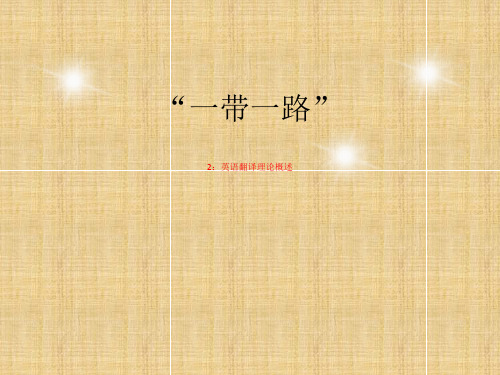
• 学成后,他曾遍游西域诸国,弘传佛法,后来 又来到中国
• 安世高可以说是佛经汉译的创始人,他首先译 介了印度小乘佛教禅类的经典。
23
第一章: 翻译理论概述
东晋至南北朝 道安
总结了比较完善的直 译原则
集体翻译 有了梵文原本 翻译理论和技巧有了
34
• 无事不登三宝殿
• 想起到寺院寻求帮助
• 不看僧面看佛面
•
• 当头棒喝
•
悟解能力。现比喻促人醒悟的打击或警告
35
第一章: 翻译理论概述
• “一厢情愿
《百喻经》。
说的是一个愚人爱上了公主,害了单相思的故事。
后被广泛运用,多泛指单方面的愿望和计划。
• “醍醐灌顶”出自佛教。“醍醐”是从牛乳中提炼 的精华,比喻佛法的最高境界;“灌顶”是佛教密 宗的一种形式,《大日经疏》言,以甘露法水灌佛 子之顶,令佛种永不断故。现比喻恍然大悟茅,塞 顿开之愉悦。
7
• 意译(free translation)是指将一种语言 所表达的意义用另一种语言做释义性解 释,在转换过程中不必过分拘泥于原文 形式。
• 意译强调“神似”,主张依照原文的意 义,灵活机动地把原文意义创造性地表 达出来
8
• day student • “走读生” • eat one’s words • 收回某人的话 • Shakespeare put his hometown on the map. • 莎士比亚使他的家乡闻名天下。 • Stratford-upon-Avon埃文河畔斯特拉特福
32
第一章: 翻译理论概述
唐宋时期
主译为本国僧人为多 且都精通梵汉 深晓佛理译经计划性强 节译少全译多 译场制度完备 所译佛经忠实原著。 四大佛经翻译家有两人玄奘和
第一章 汉英翻译概述
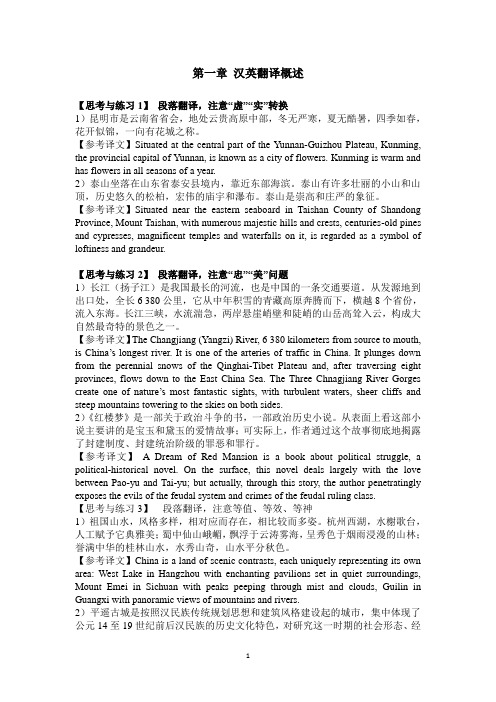
第一章汉英翻译概述【思考与练习1】段落翻译,注意“虚”“实”转换1)昆明市是云南省省会,地处云贵高原中部,冬无严寒,夏无酷暑,四季如春,花开似锦,一向有花城之称。
【参考译文】Situated at the central part of the Yunnan-Guizhou Plateau, Kunming, the provincial capital of Yunnan, is known as a city of flowers. Kunming is warm and has flowers in all seasons of a year.2)泰山坐落在山东省泰安县境内,靠近东部海滨。
泰山有许多壮丽的小山和山顶,历史悠久的松柏,宏伟的庙宇和瀑布。
泰山是崇高和庄严的象征。
【参考译文】Situated near the eastern seaboard in Taishan County of Shandong Province, Mount Taishan, with numerous majestic hills and crests, centuries-old pines and cypresses, magnificent temples and waterfalls on it, is regarded as a symbol of loftiness and grandeur.【思考与练习2】段落翻译,注意“忠”“美”问题1)长江(扬子江)是我国最长的河流,也是中国的一条交通要道。
从发源地到出口处,全长6 380公里,它从中年积雪的青藏高原奔腾而下,横越8个省份,流入东海。
长江三峡,水流湍急,两岸悬崖峭壁和陡峭的山岳高耸入云,构成大自然最奇特的景色之一。
【参考译文】The Changjiang (Yangzi) River, 6 380 kilometers from source to mouth, is China’s longest river. It is one of the arteries of traffic in China. It plunges down from the perennial snows of the Qinghai-Tibet Plateau and, after traversing eight provinces, flows down to the East China Sea. The Three Chnagjiang River Gorges create one of nature’s most fantastic sights, with turbulent waters, sheer cliffs and steep mountains towering to the skies on both sides.2)《红楼梦》是一部关于政治斗争的书,一部政治历史小说。
翻译理论与实践(全套PPT课件)
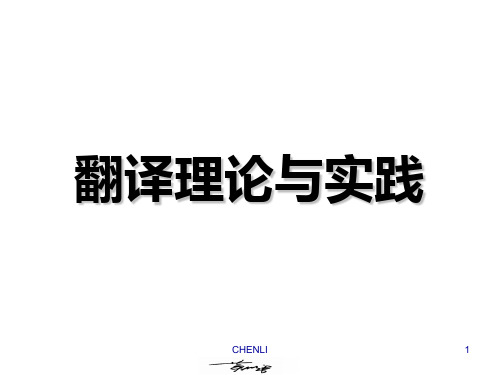
CHENLI
12
导学——课程要求
Tests: 60% There will be only one test: a final. But there may also be
several short quizzes through the term. Attendance: 20%
Daily attendance will be recorded. Each time a student will get 2.5 points. 1point for attendance, 1 point for being on time, and 0.5 point for participating in discussion and interacting positively with fellow classmates.
CHENLI
13
导学——课时安排
课时安排:
教学内容
导学 第一章:翻译概述 第二章:英汉语言对比 第三章:词语的翻译 第四章:句子翻译技巧(上) 第五章:句子翻译技巧(下) 第六章:常见文体的翻译
注:可能 因授课实际情况,课时安排会做适当调整。
CHENLI
课时 2 2 2 2 2 2 4
14
导学——学法指导
Main Language points: 1. Comparative studies of language family 2. Comparative studies of word building in English and
Chinese 3. Comparative studies of syllable
Exercise
CHENLI
5
第三章:词语的翻译
Chapter 1工程英语翻译概述
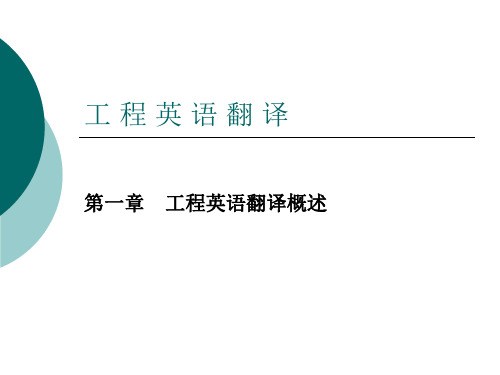
通顺是指译文语言要符合规范,行文通顺。要力争 做到忠实与通顺的辩正统一。
一方面要防止对忠实的片面理解,一味追求形式上 的相似,造成逐字死译。另一方面又要防片面强调 “通顺”,而不忠实于原文。
工程英语注重逻辑性,因此分词连接成分 (Participle Connectors) 的使用率很高, 例如:
Supposing that …假定、假设 Assuming that …假定、假设 Provided that …倘若、只要 Seeing that …由于、鉴于
3. 透彻分析深层结构
Examples:
1.Progress control is obtained by comparing actual performance on the work against the desired performance set up on the master or detailed schedules. 进度控制是通过比较工程实际进度与主要(或详细) 进度表中确定的预期进度来进行的。
工程英语翻译
第一章 工程英语翻译概述
Warm-up Exercise
Placing is the process of transferring the fresh concrete from the conveying device to its final place in the forms. Prior to placing, loose rust must be removed from reinforcement, forms must be cleaned, and hardened surfaces of previous concrete lifts must be cleaned and treated appropriately. Placing and compacting are critical in their effect on the final quality of the concrete. Proper placement must avoid segregation, displacement of forms or of reinforcement in the forms, and poor bond between successive layers of concrete.
翻译绪论

第一章:翻译概述(上)——翻译的过程
例2 Eager to trust but determined to verify, many single women in an age of risky romance are hiring private detectives to check the background of their suitors. (《中国翻译》, N0.5, 1997) 【译文】这个年月,就连谈情说爱都有暗礁。许多 单身女子对向自己求婚者既急切地想以身相 许,却又想知道对方是否靠得住,于是就纷 纷雇用私人侦探去查清对方的身世经历。
The Oxford English Dictionary: to Dictionary of Webster’s third New International turn from one “换易言语使相解也” (【唐】贾公彦《义疏》) the English Language: to turn into one’s own or language into another (从一种语言转换成另一种语 another language(转换成本族语或另一种语言) 言);
4. 译商网 /Resourcehtml/Resource413.html
5. 译龙翻译网/sp 6. 词汇术语网 /news/a1/1.htm
许昌学院外国语学院
课程名称:英汉互译
授课人:曾尔奇
Chapter One Introduction to Translation
(第一章 翻译概述)
第一章:翻译概述——教学目标
Teaching Objectives
Knowledge Objective: to know the definition , scope , and process (key point) of translation Ability Objective: be able to use some terms of translation exactly Moral Objective: try to be objective and
[工学]商务英语翻译第一章
![[工学]商务英语翻译第一章](https://img.taocdn.com/s3/m/fe493ae589eb172ded63b783.png)
鲁迅
中国现代伟大的文学家和翻译家 和新文学运动的奠基人。青年时 代受进化论思想影响。1902 年去日本留学,原学医,后从事 文艺等工作,企图用以改变国民精 神。1909年回国,先后在杭州、绍兴任教。
商务英语实质上就是商务活动与英语语
言的综合,它具有专业性、规范性、简 明性、具体性等特点,并具有以下主要 功能: 1.信息功能,即为商务活动参与者提 供信 息; 2.交际功能,即帮助商务活动参与者 进行交流和沟通; 3.祈使功能,即促使商务活动参与者 5~1976),文学家。 原名和乐,改名玉堂、语堂,笔 名毛驴。早年留学美国、德国。 1923年回国,在北京大学、北京 女子师范大学任教,支持爱国学 生运动。1936年旅居美国。1947 年任联合国教科文组织美术与文学主任。1954年任 新加坡南洋大学校长。1966年定居台北。《生活的 艺术》、《吾国与吾民》。
商务英语翻译的最高标准是“功能对等”,即经过
翻译,译文与原文之间在信息内容、信息承载方式、 交际目的(预期功能)和交际效果等方面最大限度地 保持不变,这样的翻译就称得上“功能对等”。为 此,译文必须做到“忠实、得体和统一”。“忠实” 是“功能对等”的必要条件,“得体”和“统一” 是“功能对等”的充分条件。
当今世界国际交流日益频繁,科技发 展日新月异,对翻译的需求越来越大。 据估计,我国目前从事翻译的人多达 100 万左右;人口仅520万的丹麦,从事翻译 工作的竟有一万人之众; 因特网上,每 天需要翻译的文字,多达130万页;而这 个数字还在增加。翻译的重要性由此可 见一斑。
汉译英概述

•
Hale Waihona Puke ••二、翻译标准的运用
我国外文出版发行事业局关于翻译标准的意见
•
1.译文必须忠实于原文。这是指忠实于原文的意 思和风格,也就是把中文内容用外文正确地表达出来。 • ‚各种不同内容的文章,各有各的体裁和专门术 语,翻译马克思列宁夫义经典著作必须采用马克思列 宁主义的术语和表达方法;翻译文艺作品、必须使用 文学语言。‛ • 2.译文必须是流畅的外文。译文必须合乎译入外 文的语言习惯.让使用这种民族语言的读者正确了解 原意。如果不尊重外文的语法习惯,把中文的某些特 殊的语法结构瞎搬到译文中去,读者就会看不懂。
沁园春· 雪 Snow To the tune of Spring Beaming in Garden
• • • • • • • • • • 北国风光, • 千里冰封, • 万里雪飘。 • 望长城内外, • 惟余莽莽; • 大河上下, • 顿失滔滔。 • 山舞银蛇, • 原驰蜡象, • 欲与天公试比高。 • What a scene is in the north found! A thousand li of the earth is ice-clad aground, Ten thousand li of the sky is snow-bound. Behold! At both sides of the Great Wall An expanse of whiteness conquers all; In the Yellow River, up and down, The surging waves are gone! Like silver snakes the mountains dance, Like wax elephants the highlands bounce, All try to be higher than heaven even once!
- 1、下载文档前请自行甄别文档内容的完整性,平台不提供额外的编辑、内容补充、找答案等附加服务。
- 2、"仅部分预览"的文档,不可在线预览部分如存在完整性等问题,可反馈申请退款(可完整预览的文档不适用该条件!)。
- 3、如文档侵犯您的权益,请联系客服反馈,我们会尽快为您处理(人工客服工作时间:9:00-18:30)。
第一章:翻译概述——翻译的标准
1.3 Criteria in China
• A. Yan Fu’s (严复) “three character guide”, which was first proposed in 1898, is the principle of
“faithfulness, expressiveness, and elegance” (信、达、
3
第一章:翻译概述——翻译的定义
1.1 What is translation?(翻译的定义)
• The Oxford English Dictionary: to turn from one
language into another(从一种语言转换成另一种
语言); • Webster’s third New International Dictionary of the English Language: to turn into one’s own or another language(转换成本族语或另一种语言)。
8
第一章:翻译概述——翻译的定义
Alexander Fraser Tytler:
A good translation is one which the merit of the
original work is so completely transfused into another language as to be as distinctly apprehended and as strongly felt by a native of the country to which that language belongs as it is by 好的翻译应该是把原作的长处完全地移注到另一种语
5
• 翻译是将一种文字之真义全部移至另一种文字而 绝不失其风格的神韵。(吴献书,1949) • 翻译是用一种语言把另一种语言所表达的思维内 容准确而完整地重新表达出来的语言活动。(张 培基,1980) • 翻译的实质是语际的意义转换。(刘宓庆,1990) • 翻译的定义应该是:“将一种语言传达的信息用 另一种语言传达出来。”(蔡毅,1995) • 翻译是将一种语言文字所蕴含的意思用另一种语 言文字表达出来的文化活动。(王克非,1997) • 翻译是语际之间的信息传递和语族之间的文化交 流。(萧立明,2001)
著名的翻译三原则: ( 1 )译文应完全复写出原作的思想( A translation should give a complete transcript of the ideas of the original work.)(“信”)
21
• (2)译文的风格和笔调应与原文的性质相同(The style and manner of writing should be of the same character as that of the original.)(“雅”) • (3)译文应和原作同样流畅(A translation should have all the ease of the original composition.) (“达”)
17
• 林语堂:忠实、通顺和美 • faithfulness, smoothness, beauty
18
• 许渊冲 • 诗歌翻译 • 三美原则:意美、音美、形美
19
• 刘重德:信、达、切 • faithfulness, expressiveness and closeness
20
第一章:翻译概述——翻译的标准
雅).
• “译事三难:信、达、雅” ⊙信:忠实于原文 ⊙达:文笔流畅 ⊙雅:文风典雅 (士大夫) --保持原文的风格
14
• 鲁迅:信和顺 “凡是翻译,必须兼顾着两面,一当然力求其易解, 一则保存原作的风姿。” 宁信而毋顺 vs 赵景深:Milky Way=牛奶路 我的翻译向来是用直译法……我现在还是相信直译 法,因为我觉得没有更好的办法。 保留一定的洋腔洋调
6
第一章:翻译概述——翻译的定义
The definition is:
• Translation is a rendering from one language into another, i.e., the faithful representation in one language of what is written or said in another language. • To be more exact, in Nida’s & Tytler’s words
22
第一章:翻译概述——翻译的标准
美国翻译理论家Eugene A. Nida:
• 把翻译中的“意义”概括成“语义”和“语 体”:
• Translating consists in reproducing in the receptor language the closest natural equivalent of the source-language message, first in terms of meaning and secondly in terms of style. • (所谓翻译,是指在译语中用最切近而又自然 的对等语再现原语的信息,首先在语义上,其 次在文体上。)
– 关于译者的比喻 – A courier of the human spirits (普希金) – A sculptor who tries to recreate a work of painting – A straitjacketed dancer – A musician / an actor – Traduttori-traditori (Translators are traitors.)
15
• Fu Lei’s (傅雷) • spiritual conformity/resemblance in spirit (神似)
“以效果而论,翻译应当像临画一样,所求的不在 形似而在神似。” 译文同原文在内容上一致,这叫“意似”,是翻 译的最低标准。译文同原文如果能在形式上和精 神上同时一致起来,或称“形似”和“神似”, 这是翻译的高标准。 理想的译文仿佛是原作者的(中文)写作。
• 翻译是一种“语言转换”活动。
4
• 翻译是将一种文字之真义全部移至另一种文字而 绝不失其风格的神韵。(吴献书,1949) • 翻译是用一种语言把另一种语言所表达的思维内 容准确而完整地重新表达出来的语言活动。(张 培基,1980) • 翻译的实质是语际的意义转换。(刘宓庆,1990) • 翻译的定义应该是:“将一种语言传达的信息用 另一种语言传达出来。”(蔡毅,1995) • 翻译是将一种语言文字所蕴含的意思用另一种语 言文字表达出来的文化活动。(王克非,1997) • 翻译是语际之间的信息传递和语族之间的文化交 流。(萧立明,2001)
one language the ideas which have been
expressed in another language.
10
第一章:翻译概述——翻译的分类
1.2 Scope of translation • In terms of language 1. Intralingual translation (语内翻译) 2. Interlingual translation (语际翻译) a. Native languages into foreign languages b. Foreign languages into native languages
7
第一章:翻译概述——翻译的定义
美国翻译理论家Eugene A. Nida:
• Translating consists in reproducing in the receptor language the closest natural equivalent of the source-language message, first in terms of meaning and secondly in terms of style. • (所谓翻译,是指在译语中用最切近而又 自然的对等语再现原语的信息,首—课时安排
课时安排:
教学内容 第一章:翻译概述 课时 2
第二章:英汉语言对比
第三章:词法翻译技巧 第四章:句法翻译技巧 第五章:四级考试翻译解题技巧 复习
2
12 12 4 2
2
第一章:翻译概述
教学内容:
1.1 翻译的定义
1.2 翻译的分类 1.3 翻译的标准 1.4 翻译的过程 1.5 中、西译史
12
• 1. 2. 3. 4. • 1. 2. 3.
In terms of materials Scientific materials Translation of literary works Translation of political essays Translation of practical writing In terms of disposal full-text translation abridged translation adapted translation
16
Qian Zhongshu (钱钟书) transmigration (化境) “文学翻译的最高标准是‘化’。把作品从一 国文字转变成另一国文字,既能不因语文习惯的 差异而露出生硬牵强的痕迹,又能完全保存原有 的风味,那就算得入于‘化境’。” 所谓“化境”,就是原作向译文的“投胎转 世”,文字形式虽然换了,而原文的思想、感情、 风格、神韵都原原本本地化到了译文的境界里了, 丝毫不留下翻译的痕迹,让读者读译作就完全像 在读原作一样。
those who speak the language of the original work. 言,以使译人语所属国家的本地人能明白地领悟、强烈
